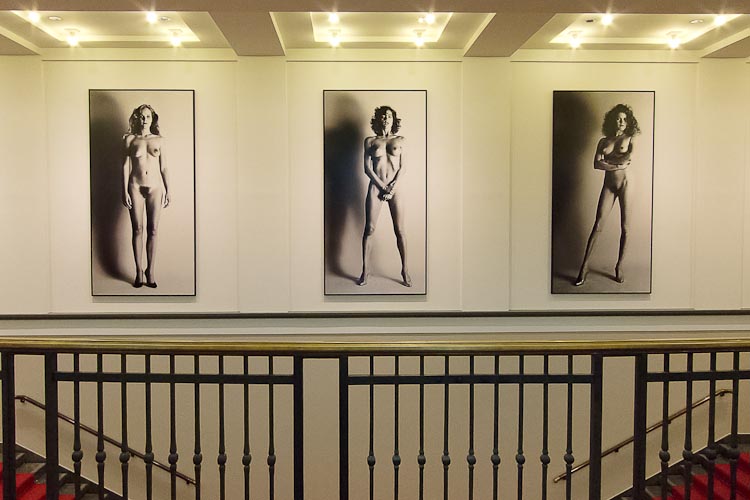Considered as one of the most renowned fashion photographers of the 20th Century, Helmut Newton changed the way in which photography portrayed the latest style. Creating moods and stories next to the photos, he invented a new world women could aspire to, evident in the exhibition displayed in this neo-classical building today. Newton was known for pushing boundaries for professional and personal work, in images that would have once been considered too explicit for the eye. However, here they are in over-sized black and white canvases with full, powerful visuals that show exactly what he stood for. The exhibition is a build-up of early work to later work showing the progression he made through the industry. The museum holds a calm atmosphere similar to that of Newton’s photo shoots and enables you to saunter through each room, from large famous images to the movies he was involved in.
Many of the images Newton created were of women with no clothes on. It was these images that brought the most meaning and fame to Newton however it was also these images that brought the most critics and controversy. Some claim that these ‘naked’ images are the reduction of female sexuality. It is interesting here to discuss the difference between naked and nude and how this can effect what we see in Newton’s photos. When people hear the word naked they think of vulnerability and exposure. Newton’s images do not display women who look vulnerable, in fact they show the opposite. The woman are displayed as powerful versions of themselves, showing authority over fear. We can then consider them to be closer to the vision of nudity, in which we imagine a classier, more put together image. Others do not see Helmut’s imagery this way.
His photography was the centre of fashion controversy – what should and should not be shown of a woman. Feminists of the time declared his work to be a reduction of the female sexuality to the silent exhibition of the naked body. They felt it was wrong to show-off this intimacy to the rest of the world. Many assumed Newton was creating objects out of the women he used. However Newton was simply diving into the world of the ‘unaccepted.’ In fact Newton repeatedly said that he actually loved and admired women and wanted to portray the female strengths to their fullest. Once you look at the bigger picture in other creative fields we see more intense examples of females being used as an object. Through social media in the current day women voluntarily look for likes and attention from men with no meaning or reason. Helmut Newton creates images with an idea and story behind them making them more of an art piece.
The women themselves were the centre of the stories he created and only used them to magnify what he loved most in them – their power. Despite him not showing their emotional interior we still see a fiery image with a meaningful backdrop. The women used are sensual but very real despite their top of the game model look. Newton doesn’t show them with an unattainable perfection, not hiding their natural appearance or flaws from our vision. The vision is actually more personal and empowering, especially when you stand in front of a wall sized image of confident ladies strutting with sexual independence.
It is when you are surrounded by this confidence and power that you realise we miss something today. We miss this creation of an aspirational idea of the self. Woman can look at these images and can picture themselves looking this way, an achievable kind of beauty. Today we are confronted with images of perfect, edited women and wonder why girls are constantly questioning their appearance and worth. We can learn from Helmut Newton how to show a woman as a powerful being giving us an image to look up to, not for what they look like but how they are confident in their own bodies. Who will be the next to step up to Helmut’s socially challenging style?


No comments:
Post a Comment